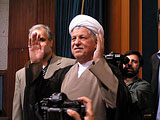A New Dynamic in Iran
By Kamal Nazer Yasin for ISN
For nearly two decades, the Khamenei-Rafsanjani dynamic has either been at the heart of political developments or else figured as a contributing factor. In fact, no understanding of the Islamic Republic's internal changes can be said to be complete without a full understanding of this special relationship.
In the last three months, the dynamic has undergone two phase-changes. The first major change took place on 3 June – the date of a historic presidential debate between reformist candidate Mir-Hossein Mousavi and incumbent President Mahmoud Ahmadinejad.
Then, Ahmadinejad fired the opening salvos in what has become known as Ahmadinejad's palace coup against his and Supreme Leader Khamenei's political rivals. In that debate, the incumbent president publicly accused Rafsanjani of corruption, perfidy and theft of public property. In the following days, Rafsanjani tried first to have Khamenei condemn and disassociate himself from the coup and then have him stop further attacks on him and his family. Khamenei refused, making his complicity clear.
The new dynamic after this has been one of total enmity between the two strongmen.
With the partial failure of the political coup - thanks to the mass protest movement - Khamenei used his now-famous 19 June Friday Prayer sermon to half-apologize to Rafsanjani and retract his earlier positions. Rafsanjani ignored Khamenei's olive branch and instead went on the offensive against the Supreme Leader.
First, through his allies in the Assembly of Experts, which he chairs, he floated informal proposals to remove Khamenei or dilute his powers; and then he used the same Friday Prayer site to slight Khamenei publicly and endorse the main objectives of the protest movement. Rafsanjani remained silent on his relations with Khamenei for the next few weeks.
For his part, Khamenei reverted to attacking Rafsanjani in public and private conversations.
On 29 August, after two other statements published in local media had indicated a phase-change in relations between Rafsanjani and Khamenei, the newspaper Vatan-e Emrouz, published by an associate of Ahmadinejad, claimed that Rafsanjani had told a private audience that Khamenei was the leading force standing up to schemers against the Islamic Republic. "The Supreme Leader's prescience and sagacity is foiling plots to change the character of the revolution and the state," he was quoted as saying.
Again, while some observers may be tempted to interpret this statement as one targeting Ahmadinejad and his backers, the very choice of words used indicates a course adjustment on the part of Rafsanjani. And it would seem, indeed, that Rafsanjani is now withdrawing his support for Mousavi and the protesters, and, according to the hard-line newspaper Kayhan, “has cleverly saved his own skin” through capitulation to Khamenei.
"There is little wonder that Hashemi [Rafsanjani] has abandoned the main instigators of the plot," wrote Kayhan. "They wanted to join these forces together to topple the system under the pretext of opposing the president while this lame-duck excuse doesn't fool a small shopkeeper [...]. Rafsanjani was much too smart to fall for this scheme."
Although it is somewhat premature to refer to the new situation as a lasting new phase, there are strong indications that that may indeed be the case.
Crucially, the reasons for this new phase lie not in Rafsanjani's capitulation, as claimed by the hardline press, but by Khamenei's increasing fear of Ahmadinejad as a loose cannon at best and a dangerously ambitious politician at worst.
Ahmadinejad has defied the Supreme Leader in ways not seen in the Islamic Republic in the past 30 years.
Most recently, on 26 August, Khamenei stated that there was evidence pointing to a linkage between the protest movement and foreign powers. He also cautiously condemned torture and political assassinations. Two days later, Ahmadinejad contradicted the Supreme Leader by denying any human rights violations or foreign connections to the protests.
While such contradictions and maneuverings are considered as normal or healthy in many countries in the world, they are unheard of in Iran, where the Supreme Leader's words are definitive.
According to several reports, the Supreme Leader and his aides are extremely apprehensive about the unruliness of the president. A reliable source who insisted on his anonymity confided to ISN Security Watch that Khamenei was the one calling on Rafsanjani for a truce. This was, in part, according to the source, designed to counter-balance Ahmadinejad's waywardness and blind ambition – especially at a time when the president appears to be attempting to oust Rafsanjani from power.
Newspapers have reported recently that Rafsanjani's daughter-in-law had been briefly detained and released by forces loyal to Ahmadinejad last month. In addition, in one of several show trials against dissidents and protest leaders, Hamzeh Karimi, a detainee who gave a forced confession, claimed that Rafsanjani's son, Mohsen, had given him a huge sum from illegal funneling of public funds for the express purpose of use in anti-Ahmadinejad political campaigns. Finally, the head of the Revolutionary Guards, General Mohammad Hejazi stated on 1 September that Khatami and Rafsanjani's son were part of a nefarious plot to topple the Supreme Leader.

